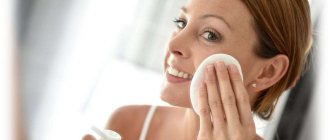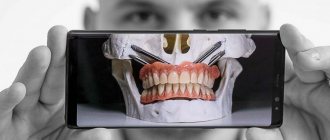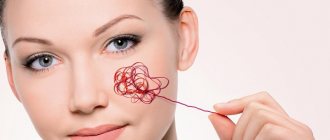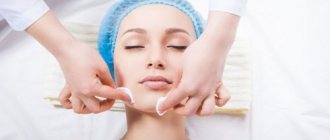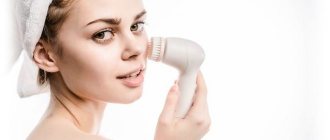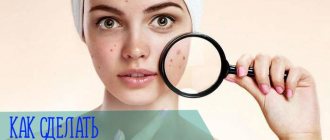Retinoic yellow peeling
Retinoic yellow peeling gets its name because of the bright color of the active ingredient that is used to treat the skin. The main substance of the composition is retinoic acid or retinol - a derivative of vitamin A or vitamin A, which is why the peeling is called retinoic or retinol yellow peeling.
Peeling with retinoic acid is a procedure with a chemical surface effect, but despite this, this method of rejuvenation is very effective and the results obtained are no worse than the average peeling.
How does retinoic peel work?
The main substance helps speed up the work of dermal cells, which causes them to intensively produce collagen and elastin. In addition, retinoic acid has a bacterial effect, accelerates metabolism in cells, enhances reduction and oxidation processes, and accelerates the production of lipids.
In addition to the active component, the composition also contains other additional acids that help get rid of age spots and also enhance the effects of retinoic acid. This peeling is prescribed for treating the face, décolleté, face, eyelids and hand skin. Since yellow peeling is superficial and has a gentle effect on the skin without damaging it, it can also be performed on young girls.
Retinoic peeling has the following advantages:
- short rehabilitation period – up to 4 days;
- despite its mild effect, it is highly effective, especially in the fight against age spots;
- to achieve results, a much smaller number of sessions are required compared to peelings with other acids;
- is a safe way of rejuvenation;
- minimal risk of side effects.
Also, compared to other peels, retinoic peels have an affordable price.
Cost of the procedure
For people interested in skin rejuvenation, the price of retinoic peeling becomes relevant. Today, specialists in various salons perform the procedure for only 4-6 thousand rubles per session. For those with normal skin, for which two sessions are enough, paying for peeling will not be difficult. But those who require a course of treatment consisting of 4 procedures will have to spend a considerable amount of money.
The price of retinoic peeling is acceptable to many clients. For this money they get an incredible effect that they cannot achieve on their own.
Retinoic facial peeling
Since yellow peeling has a mild effect, but at the same time is highly effective, this method of improving skin condition can be used to combat age-related changes, as well as at a young age. Facial peeling with retinoic acid is carried out in case of increased pigmentation, the presence of scars and acne scars, and facial wrinkles. Retinoic peeling can be used as a preventative measure for malignant skin diseases.
Yellow peeling is indicated for the following skin conditions:
- decreased skin tone;
- sagging, lack of elasticity and firmness;
- acne, pimples;
- dark spots;
- dullness of the skin;
- presence of scars and scars from acne;
- expression wrinkles.
This peeling helps prevent early skin aging and is also prescribed as a preparatory procedure before dermoplasty.
After yellow peeling, the following changes occur:
- the process of cell regeneration is accelerated;
- blood circulation improves at the peeling site;
- improves the process of collagen production;
- the level of oiliness and hydration of the skin is normalized;
- the skin restores its smoothness and elasticity;
- pigmentation is eliminated, the skin looks healthy and fresh;
- the structure is aligned.
Retinoic peeling has a positive effect on the skin after the first procedure, which in some cases is sufficient in the absence of serious problems with the skin. In most cases, for effectiveness it is necessary to carry out 3-4 procedures, between which it is necessary to maintain a gap of 2 weeks. The exact number of sessions can only be determined by a cosmetologist after a preliminary consultation.
Who needs peeling?
The procedure is intended for those with mature skin. It is for this reason that older women most often leave reviews about retinoic peeling. Photos before and after the session make it clear that the procedure is truly effective and worthy of attention.
As a rule, patients aged 35-50 years turn to peeling. For younger women, the procedure will be useful in the following cases:
- overly rich and bright pigmentation;
- many pimples and blackheads;
- too strong activity of the sebaceous glands;
- pronounced acne scars;
- first destructive skin changes;
- skin diseases.
How to prepare for the procedure
Before carrying out yellow peeling, mandatory preparation is required; you need to start 1-2 weeks in advance. If necessary, the cosmetologist may recommend light peeling to soften the skin. The doctor also prescribes special creams based on glycolic acid, which will prepare the skin for the procedure, this will help the active ingredients penetrate as deeply as possible under the skin.
It is important not to hide from the cosmetologist about the presence of any acute infectious diseases, poor health, malaise and taking medications. If there are any, a visit to a cosmetologist should be postponed for a while.
Is it permissible to use foundation, on what day can it be applied?
Foundation or fluid is the basis of any makeup. You should forget about it for 2 weeks after peeling, or even more, and after this period, take care of purchasing a high-quality foundation with sun protection (SPF).
Important ! Before you start using foundation after peeling, you need to consult a cosmetologist.
A cheap foundation can ruin your skin - it clogs your pores. Therefore, low-quality cosmetics are definitely not suitable. It is better if the cosmetologist recommends a manufacturer or line of products that can be used after peeling.
The essence of the procedure
Yellow peeling looks similar to a regular mask. Before the procedure itself, the specialist mixes the product in a container; if necessary, additional substances are added to help saturate the skin.
After the composition is ready, the patient lies on the couch and the cosmetologist begins to peel in stages:
- Before applying the peeling itself, the cosmetologist cleanses the surface of the skin from impurities, makeup, dust and sebaceous fat using a product.
- After cleansing, a composition consisting of glycolic and salicylic acid is applied to the skin, which will help prepare the skin and soften the stratum corneum as much as possible. After some time, the cosmetologist removes the remaining product and proceeds to the next stage.
- Using a cosmetic spatula, peeling is applied to the skin; it should be distributed as much as possible over the skin and have a dense but thin layer. When applied, the specialist does not affect the eyelid area, as well as the growth areas of eyelashes, hair and eyebrows.
The mask must be kept on the face for about 20 minutes, during which time it becomes harder. After time, the mask is removed with a film and the cosmetologist treats the skin with a special product with a high degree of sun protection.
Ingoda, the procedure can be carried out a little differently:
- Cleansing the skin with a salicylic acid-based product.
- Peeling is applied in several thin layers until slight redness appears.
- After several hours, the product is washed off with water and then treated with the product.
The method depends on the condition of the skin and the desired result.
After how many days can I apply makeup?
Girls are warned in advance, even before the procedure, that after it they will have to forget about decorative cosmetics for a while . Usually, a cosmetologist gives instructions on the period of refusal of makeup on an individual basis, because a lot depends on the type of peeling, skin sensitivity, and personal characteristics.
On average, until the skin has completely healed (12-14 days), cosmetologists do not recommend using cosmetics. But skincare cosmetics have their place. Even the cosmetologist himself, after the procedure, can make a list of products that can be used. These will definitely be soft nourishing and moisturizing products that can be used a day after peeling, and always with sun protection (SPF).
We recommend: 3 reasons why the skin peels off after peeling, and what to do in this case?
Post-peeling care
Compared to the recovery period for other types of peels, which is usually about 2 weeks, the recovery period for the yellow peel takes only 5 days.
Skin treated with peeling during these days requires special care: regular use of masks, special moisturizers and nourishing products.
After the procedure, the cosmetologist gives the following recommendations:
- do not use decorative cosmetics and products containing retinoic acid;
- during this period, do not carry out hair curling, dyeing, etc. procedures;
- it is necessary to use only herbal natural remedies that can reduce irritation and inflammation;
- when peeling, do not touch the skin with your hands;
- wash only with boiled water;
- use masks with lactic acid, which will moisturize the skin and help the skin renew itself much faster.
During this period, it is strictly forbidden to use scrubbing agents and be in the open rays of the sun.
Indications and contraindications
Indications for the procedure are the following conditions:
- acne;
- excessive skin pigmentation, including that resulting from exposure to UV rays of the sun;
- age-related skin changes;
- early aging of the skin caused by sunlight;
- deficiency of collagen synthesis;
- expression wrinkles;
- disorder of skin water balance;
- hyperkeratosis;
- loss of skin firmness and elasticity;
- before dermatoplasty.
You should avoid yellow peeling if you experience:
- the period of bearing a child and breastfeeding, as well as planning conception during the year, since retinoids can negatively affect the fetus;
- chronic dermatological pathologies in the acute stage;
- herpetic skin lesions, because after the procedure there is a relapse of the disease, such patients are prescribed antiviral agents for oral administration before peeling at the preparatory stage;
- treatment with oral forms of retinoids;
- liver pathologies;
- dilation of facial skin vessels;
- rosacea;
- flat warts, since the procedure will cause further spread of the virus;
- molluscum contagiosum;
- hypersensitivity to active substances used for peeling;
- taking certain medications, so after treatment with Roaccutane, the procedure can be carried out at least 6 months later.
Retinol peeling should be used with caution if you have sensitive facial skin.
Contraindications
Like any type of peeling, retinoic peeling has contraindications:
- increased sensitivity to peeling components;
- the presence of acute viral diseases;
- warts and moles on the treated area;
- increased sensitivity to sun rays;
- taking certain medications;
- pregnancy;
- breastfeeding period;
- skin diseases;
- liver diseases.
When planning a pregnancy, you should not use retinoic peeling; it is better to resort to other methods of cleansing the skin.
If the patient constantly suffers from allergic reactions, in order to avoid complications, the doctor performs a sensitivity test; if there is no reaction, the cosmetologist performs the procedure.
Preparing for the session
Before skin rejuvenation, certain preparation for retinoic peeling is required. First of all, the specialist determines the type and condition of the skin, the tendency to allergies, as well as the presence of various ailments that may interfere with peeling. Immediately after this, the client is prescribed certain creams, which must be used for several weeks in a row. Most often, these products are based on glycolic acid. Thanks to them, the skin softens, which allows retinoids to easily penetrate to a greater depth. In the absence of proper preparation, the effect of the procedure may be several times less.
Retinol peeling requires avoiding tanning salons, using exfoliants, and long-term sun exposure. During the week before the procedure itself, you should remove yourself from all this so as not to damage the skin.
Side effects
Before performing the procedure, the cosmetologist warns the patient about possible side effects that can be avoided by following all the specialist’s recommendations. It is also important that the procedure is performed only in specialized centers where they use high-quality products and employ only qualified workers.
A reaction can occur due to the individual characteristics of the body, so it is important to inform the cosmetologist about the presence of diseases, which will reduce the risk of complications several times.
A couple of days after the procedure, the following side effects may occur:
- dry skin;
- tightness;
- peeling;
- the appearance of pink areas and redness;
- soreness;
- increased skin sensitivity;
- swelling.
These side effects almost always occur, which is the norm. To relieve discomfort, you need to use special products prescribed by a specialist that can moisturize and soothe the skin.
Mediderma retinoic peeling
Retinoic peeling Mediderma is a professional skin care product produced by a Spanish cosmetology company. Mediderma has a wide range, which includes compositions for any type of peeling: superficial, medium or deep. Mediderma is an effective and safe means for skin rejuvenation; in addition, it has a minimal list of side effects that do not appear with proper care.
In addition to retinoic acid, the Mediderma yellow peeling contains lactic acid, which helps get rid of age spots, refresh and brighten the skin. This remedy is useful if you have fresh stretch marks.
What and how to wash after chemical and other procedures?
Next, find out why you should not wash your face immediately after the procedure, when and how to do it correctly, and also what is the best way to carry out water procedures. Since careful and gentle skin care is necessary after peeling, special requirements are put forward for washing. Depending on the type of peeling, washing can be done at different intervals.
After superficial peeling, you can wash your face after 12 hours, after medium peeling - after 1-2 days.
Cosmetologists usually recommend washing your face when your skin feels tight and a noticeable film or crust forms on your face. Suitable for washing after cosmetic procedures :
- boiled water at room temperature;
- cream;
- soft milk for sensitive skin;
- acidified water (1 tablespoon vinegar, or the juice of half a lemon, per 1 glass of boiled water).
Acidified water:
- accelerates the process of exfoliation of dry scales;
- dries out the skin;
- disinfects the surface.
A good alternative to water with vinegar or lemon juice is a tonic with a reduced content of fruit acids.
Retinoic peeling: price
The exact cost of the procedure depends on the number of sessions that need to be performed. On average, one session costs about 4,000 rubles and can vary depending on the area of the treated area. If it is necessary to peel an additional area, an additional payment may be required. The price of the procedure is also affected by the drug used for peeling. During the conversation, the specialist can offer several types of remedies that differ in the depth of impact, effectiveness and duration of action.
How to care for your face after yellow peeling
Post-peeling care is a simple way to restore skin. It is almost the same as the usual care needed in everyday life. There are several main steps involved in this type of care, including:
- Using products that contain panthenol. It promotes rapid restoration of the epidermis after exposure to chemical elements.
- Abundant hydration. Helps restore water balance by nourishing skin cells.
These care recommendations should be used immediately the next day after the procedure. This will help not only bring the dermis into a healthy shape, but also relieve discomfort and prevent inflammation.
What to put on your face
Retinol peeling involves a long rehabilitation period. During this period of time, it is necessary to actively influence the skin of the face with special means. A professional who performed this procedure can tell you what to smear your face with. However, standard recommendations include:
- spray based on the active components of thermal water;
- masks with special enzymes;
- protective creams that prevent ultraviolet rays from entering the skin (the application layer should be as thick as possible).
It is important to use only those products that are suitable for your skin type. They are determined individually depending on the characteristics of the skin. A cosmetologist or dermatologist can help you choose the brand and type of product.

